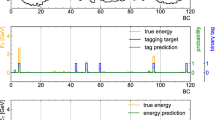Abstract
Extracting the amplitude and time information from the shaped pulse is an important step in nuclear physics experiments. For this purpose, a neural network can be an alternative in off-line data processing. For processing the data in real time and reducing the off-line data storage required in a trigger event, we designed a customized neural network accelerator on a field programmable gate array platform to implement specific layers in a convolutional neural network. The latter is then used in the front-end electronics of the detector. With fully reconfigurable hardware, a tested neural network structure was used for accurate timing of shaped pulses common in front-end electronics. This design can handle up to four channels of pulse signals at once. The peak performance of each channel is 1.665 Giga operations per second at a working frequency of 25 MHz.









Similar content being viewed by others
References
R. Grzywacz, Applications of digital pulse processing in nuclear spectroscopy. Nucl. Instrum. Meth. B 204, 649–659 (2003). https://doi.org/10.1016/S0168-583X(02)02146-8
ALICE Collaboration, Performance of the ALICE experiment at the CERN LHC, Int. J. Mod. Phys. A 29: 1430044 (2014). https://doi.org/10.1142/S0217751X14300440
ATLAS collaboration, Observation of a new particle in the search for the Standard Model Higgs boson with the ATLAS detector at the LHC, Phys. Lett. B716:1–29 (2012) https://doi.org/10.1016/j.physletb.2012.08.020
N. Petrick, A.O. Hero, N.H. Clinthorne et al., A fast least-squares arrival time estimator for scintillation pulses. IEEE Trans. Nucl. Sci. 41(4), 758–761 (1994). https://doi.org/10.1109/23.322802
G. Ripamonti, A. Geraci, Towards real-time digital pulse processing based on least-mean-squares algorithms. Nucl. Instrum. Meth. A 400(2–3), 447–455 (1997). https://doi.org/10.1016/S0168-9002(97)01012-7
M.A. Nelson, B.D. Rooney, D.R. Dinwiddie et al., Analysis of digital timing methods with BaF2 scintillators. Nucl. Instrum. Meth. A 505(1–2), 324–327 (2003). https://doi.org/10.1016/S0168-9002(03)01078-7
H.Q. Huang, X.F. Yang, W.C. Ding et al., Estimation method for parameters of overlapping nuclear pulse signal. Nucl. Sci. Tech. 28, 12 (2017). https://doi.org/10.1007/s41365-016-0161-z
P.C. Ai, D. Wang, G.M. Huang et al., Timing and characterization of shaped pulses with MHz ADCs in a detector system: a comparative study and deep learning approach. J. Instrum. 14, E03001 (2019). https://doi.org/10.1088/1748-0221/14/03/P03002
B. Denby, Neural networks and cellular automata in experimental high energy physics. Comput. Phys. Commun. 49(3), 429–448 (1998). https://doi.org/10.1016/0010-4655(88)90004-5
J. Griffiths, S. Kleinegesse, D. Saunders, et al. Pulse shape discrimination and exploration of scintillation signals using convolutional neural networks. 2018. arXiv:1611.03180
MicroBooNE collaboration, Deep neural network for pixel-level electromagnetic particle identification in the MicroBooNE liquid argon time projection chamber. arXiv:1808.07269v1
T. Roska, G. Bártfai, P. Szolgay et al., A digital multiprocessor hardware accelerator board for cellular neural networks: CNN-HAC. Int. J. Circuit Theory Appl. 20(5), 589–599 (1992). https://doi.org/10.1002/cta.4490200512
Z. Du, R. Fasthuber, T. Chen, et al. ShiDianNao: shifting vision processing closer to the sensor. ISCA ’15: Proceedings of the 42nd Annual International Symposium on Computer Architecture, vol 43, 3, pp 92–104 (2015). https://doi.org/10.1145/2749469.2750389
J. Qiu, J. Wang, S. Yao, et al. Going deeper with embedded FPGA platform for convolutional neural network. Proceedings of the 2016 ACM/SIGDA International Symposium on Field-Programmable Gate Arrays. ACM, (2016). https://doi.org/10.1145/2847263.2847265
P. Judd, A. Delmas, S. Sharify, et al. Cnvlutin2: Ineffectual-Activation-and-Weight-Free Deep Neural Network Computing. (2017). arXiv:1705.00125
A. Coates, P. Baumstarck, Q. Le, et al. Scalable learning for object detection with GPU hardware. 2009 IEEE/RSJ International Conference on Intelligent Robots and Systems, 10: 4287–4293 (2009). https://doi.org/10.1109/IROS.2009.5354084
A. Boutros, S. Yazdanshenas, V. Betz, You cannot improve what you do not measure: FPGA vs. ASIC efficiency gaps for convolutional neural network inference. ACM Trans. Reconfig. Technol. Syst. 11(3), 1–23 (2018). https://doi.org/10.1145/3242898
H. Torii, The ALICE PHOS calorimeter. J. Phys: Conf. Ser. 160, 012045 (2009). https://doi.org/10.1088/1742-6596/160/1/012045
H. Muller, R. Pimenta, Z. Yin et al., Configurable electronics with low noise and 14-bit dynamic range for photodiode-based photon detectors. Nucl. Instrum. Meth. A 565(2), 768–783 (2006). https://doi.org/10.1016/j.nima.2006.05.246
C. Farabet, C. Poulet, J.Y. Han, et al. CNP: An FPGA-based processor for Convolutional Networks. 2009 International Conference on Field Programmable Logic and Applications. https://doi.org/10.1109/FPL.2009.5272559
Y. LeCun, Y. Bengio, G. Hinton, Deep learning. Nature 521, 436–444 (2015). https://doi.org/10.1038/nature14539
P. Vincent, H. Larochelle, I. Lajoie et al., Stacked denoising autoencoders: learning useful representations in a deep network with a local denoising criterion. J. Mach. Learn. Res. 11(12), 3371–3408 (2010)
T.C. Deng, Z.B. Hu, An ultra-low-power processor pipeline-structure. Appl. Electron. Tech. 45(6), 50–53 (2019). (in Chinese)
C. Zhang, P. Li, G.Y. Sun, et al. Optimizing FPGA-based accelerator design for deep convolutional neural networks. ACM/SIGDA International Symposium on Field-Programmable Gate Arrays (FPGA2015). 161-170 (2015). https://doi.org/10.1145/2684746.2689060
P. Molchanov, S. Tyree, T. Karras, et al. Pruning convolutional neural networks for resource efficient inference. 2016. arXiv:1611.06440
A. Putnam. Large-scale reconfigurable computing in a microsoft datacenter. 2014 IEEE Hot Chips 26 Symposium (HCS). https://doi.org/10.1109/HOTCHIPS.2014.7478819
Author information
Authors and Affiliations
Corresponding authors
Additional information
This work was supported by the National Natural Science Foundation of China (Nos. 11875146 and 11505074) and National Key Research and Development Program of China (No. 2016YFE0100900).
Rights and permissions
About this article
Cite this article
Chen, JL., Ai, PC., Wang, D. et al. FPGA implementation of neural network accelerator for pulse information extraction in high energy physics. NUCL SCI TECH 31, 46 (2020). https://doi.org/10.1007/s41365-020-00756-z
Received:
Revised:
Accepted:
Published:
DOI: https://doi.org/10.1007/s41365-020-00756-z




